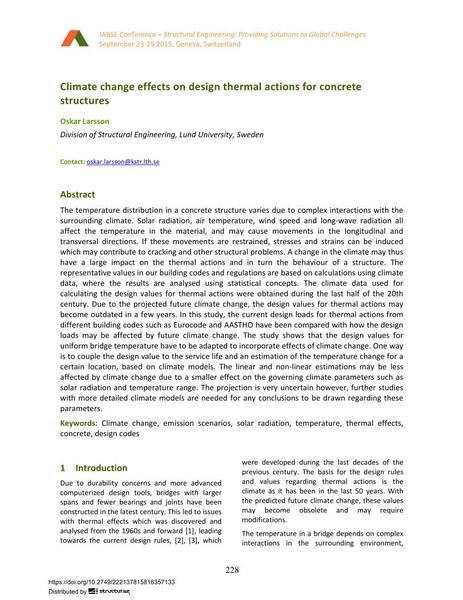Climate change effects on design thermal actions for concrete structures

|
|
|||||||||||
Bibliografische Angaben
| Autor(en): |
Oskar Larsson
(Division of Structural Engineering, Lund University, Sweden)
|
||||
|---|---|---|---|---|---|
| Medium: | Tagungsbeitrag | ||||
| Sprache(n): | Englisch | ||||
| Tagung: | IABSE Conference: Structural Engineering: Providing Solutions to Global Challenges, Geneva, Switzerland, September 2015 | ||||
| Veröffentlicht in: | IABSE Conference Geneva 2015 | ||||
|
|||||
| Seite(n): | 228-235 | ||||
| Anzahl der Seiten (im PDF): | 8 | ||||
| Jahr: | 2015 | ||||
| DOI: | 10.2749/222137815818357133 | ||||
| Abstrakt: |
The temperature distribution in a concrete structure varies due to complex interactions with the surrounding climate. Solar radiation, air temperature, wind speed and long-wave radiation all affect the temperature in the material, and may cause movements in the longitudinal and transversal directions. If these movements are restrained, stresses and strains can be induced which may contribute to cracking and other structural problems. A change in the climate may thus have a large impact on the thermal actions and in turn the behaviour of a structure. The representative values in our building codes and regulations are based on calculations using climate data, where the results are analysed using statistical concepts. The climate data used for calculating the design values for thermal actions were obtained during the last half of the 20th century. Due to the projected future climate change, the design values for thermal actions may become outdated in a few years. In this study, the current design loads for thermal actions from different building codes such as Eurocode and AASTHO have been compared with how the design loads may be affected by future climate change. The study shows that the design values for uniform bridge temperature have to be adapted to incorporate effects of climate change. One way is to couple the design value to the service life and an estimation of the temperature change for a certain location, based on climate models. The linear and non-linear estimations may be less affected by climate change due to a smaller effect on the governing climate parameters such as solar radiation and temperature range. The projection is very uncertain however, further studies with more detailed climate models are needed for any conclusions to be drawn regarding these parameters. |
||||
| Stichwörter: |
Beton Solarstrahlung Temperatur Bemessungsnormen
|
||||

